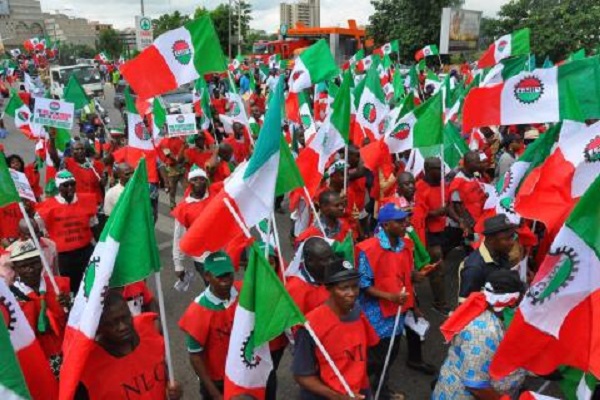Labour rejects NBS’ report of drop in unemployment rate, says it’s fiction

Organised labour
The Nigerian Labour Congress has described the drop in Nigeria’s unemployment rate released in a report by the National Bureau of Statistics on Monday as fiction, stressing that it contradicts reality.
The PUNCH reports that the NLC’s position was corroborated by the Organised Private Sector, with the OPS stating that the report was not reflective of economic realities.
The NBS in its latest report on Monday had stated that Nigeria’s unemployment rate declined to 4.3 per cent in the second quarter of 2024, signalling improved labour market conditions.
According to the report, this marks a decrease from the 5.3 per cent recorded in Q1 2024 and reflects a gradual recovery from the 5.0 per cent in Q3 2023.
The Labour Force Participation Rate rose to 79.5 per cent, up from 77.3 per cent in the previous quarter, highlighting increased workforce engagement.
The Employment-to-Population Ratio also showed significant improvement, climbing to 76.1 per cent in Q2 2024 from 73.2 per cent in Q1 2024.
This indicates that a higher proportion of the working-age population was gainfully employed during the period.
Also, self-employment remained dominant, accounting for 85.6 per cent of total employment, an increase from 84 per cent in the preceding quarter.
Informal employment also rose slightly to 93.0 per cent, highlighting the economy’s reliance on informal jobs.
Urban unemployment stood at 5.2 per cent, a reduction from 6.0 per cent in Q1 2024.
However, rural areas recorded an even lower unemployment rate of 2.8 per cent, compared to 4.3 per cent in the previous quarter.
This disparity highlights the continued role of agriculture and informal activities in rural employment, contrasting with the urban dependence on formal and service-driven jobs.
The youth unemployment rate (ages 15–24) dropped significantly to 6.5 per cent, compared to 8.4 per cent in Q1 2024.
The report further revealed gender disparities, with the unemployment rate for females at 5.1 per cent, compared to 3.4 per cent for males.
This suggests a need for targeted gender-inclusive policies to bridge the employment gap.
The report read, “The unemployment rate is defined as the share of the labour force not employed but actively searching for and available for work.
“Unemployment is one of the components of labour underutilisation. The unemployment rate for Q2 2024 was 4.3 per cent, showing an increase of 0.1 percentage point compared to the same period last year.
“The unemployment rate among males was 3.4 per cent and 5.1 per cent among females.
“By place of residence, the unemployment rate was 5.2 per cent in urban areas and 2.8 per cent in rural areas. Youth unemployment rate was 6.5 per cent in Q2 2024, showing a decrease from 8.4 per cent in Q1 2024.”
Time-related underemployment, which measures workers seeking additional hours, dropped to 9.2 per cent in Q2 2024 from 10.6 per cent in Q1.
Labour underutilisation metrics also improved, with LU2 (unemployment and time-related underemployment) decreasing to 13.0 per cent from 15.3 per cent in the previous quarter.
LU3 and LU4 metrics, which include potential labour force participation, also recorded declines to 5.9 per cent and 14.5 per cent, respectively.
NLC tackles NBS
Speaking with The PUNCH, the National Assistant General Secretary of the Nigerian Labour Congress, Chris Onyeka, labelled the report as a “voodoo document” that failled to reflect the stark realities Nigerians face daily.
Onyeka dismissed the claim that unemployment is decreasing, calling it a “fabrication designed to mislead the public.”
He argued that the data was inconsistent with the deteriorating economic landscape characterized by factory closures, dwindling manufacturing activity, and rising inventories.
“Unemployment cannot be coming down in Nigeria when factories are closing shops,” Onyeka said.
“It cannot be coming down when there is increasing inventory and reduced consumer spending. If anything, unemployment is increasing,” he added.
According to Onyeka, the lack of alignment between the data and visible realities on the ground undermines the credibility of the statistics agency.
“Once data does not reflect reality, it loses relevance. Unfortunately, the NBS has lost credibility as a result of the data they continue spewing out,” he said.
Onyeka challenged the NBS to substantiate its claims by identifying the sectors supposedly generating jobs. “Where are the jobs coming from? Is it from employers who are complaining of consumer resistance and slowing economic activities? It doesn’t add up,” he said.
He likened the report to what he described as “INEC-style manipulation,” a term he used to draw parallels between perceived shortcomings in Nigeria’s election management and the NBS figures.
“Nigerians can go to court if they don’t like the figures. But the truth remains: the NBS has become a failed institution, much like INEC in the eyes of the public,” Onyeka added.
He called for a review of the methodologies employed by government agencies to ensure that their data accurately reflects the realities on the ground.
LCCI reacts
Also, the The President of the Lagos Chamber of Commerce and Industry, Gabriel Idahosa told The PUNCH that the National Bureau of Statistics report of the unemployment rate at 4.3 per cent in the second quarter of 2024 was a “technical improvement” and not reflective of economic realities.
Idahosa said, “The technical improvement in the employment rate is more of a way that employment is now calculated; but the reality is that the economy is not looking like an economy where unemployment is significantly reducing.”
On his part, the Director of the Centre for Promotion of Private Enterprise, Dr Muda Yusuf shared the same sentiments with the LCCI President, rejecting the unemployment data as “not a true reflection of the reality of the job situation.”
Yusuf told The PUNCH he found it difficult to agree with the NBS data and called for a new methodology that reflects the country’s situation.
“Employment is about making a living. You have an engagement that cannot guarantee a source of livelihood, no matter how minimal. I’m not sure we can regard that as employment. If you look at the challenges facing the economy and the complaints by those who are supposed to be employers of labour, then you will agree with me that not many of them are actually engaging people,” he said.
The economist argued that many forms of self-employment hardly count as meaningful employment as ongoing reforms have worsened their performance as he cited the real sector’s third-quarter Gross Domestic Product figures.
“Many micro and small enterprises are struggling; that is if they are still in business,” Yusuf said. “And if you also look at the GDP data – well the GDP data ideally should reflect the health of the economy – the big sectors that normally generate jobs are slowing down.
“Agriculture just recorded 1.14 per cent GDP growth, manufacturing recorded less than 1 per cent (a 0.92 per cent GDP growth), trade where we have a lot of informal sector players recorded 0.65 per cent GDP growth. That’s less than 1 per cent.
“Real estate, which is another major source of employment, recorded 0.68 per cent. So generally, we are looking at key sectors that create jobs that are slowing down compared to last quarter. So, where are the jobs coming from?”
However, Yusuf urged the Federal Government and the private sector to consider how to create more jobs and a sustaining environment for job retention.
He remarked, “I think there’s a lot that we need to do to create the environment for more jobs to be created and retained by the entrepreneurs.
“For some of these workers, they can’t even afford transportation costs to go to their places of work. Many SMEs are struggling with the exchange rate issue, cost of transportation issues, energy issues, regulatory issues and challenges with the clearing of cargo. All of these things are depleting the amount of jobs.”
While speaking on the country’s unemployment rate, the National President of the Association of Small Business Owners of Nigeria, Dr Femi Egbesola, said the reported reduction in Nigeria’s unemployment rate, despite harsh economic conditions, can result from several factors.
He said, “These factors include changes in growth in the informal sector. Economic pressures have pushed more people into informal or subsistence work, such as trading, farming, or gig-based roles, which are now classified as metrics for employment.
“Another reason is shifts in economic dynamics, or deliberate efforts to reclassify employment statistics. For instance, the threshold for what constitutes employment (e.g., working just one hour per week) could lower unemployment figures without reflecting significant improvements in job quality or income levels.
“Recent government initiatives could be another factor. Government funding interventions, employment programs, or skill acquisition initiatives may create temporary or part-time jobs that count towards employment figures. However, while unemployment rates are a critical economic indicator, they don’t always capture the nuances of economic well-being, especially in a country like Nigeria with a large informal sector. A more comprehensive picture would include metrics like income distribution, poverty levels, and labour force participation rates.”
Meanwhile, he asserted that the rise in Nigeria’s GDP despite widespread economic hardship could be attributed to a variety of structural, methodological, and sector-specific factors.
He added, “GDP measures the total economic output and does not necessarily reflect the distribution of wealth or the living standards of citizens. One factor for the recent GDP increase is the growth in specific sectors. Certain sectors may contribute disproportionately to GDP growth, even if their benefits don’t trickle down to the general population: Examples are Oil and Gas, Agriculture, Trade, and Exports, which may inflate GDP figures.
Another factor is inflation’s role in nominal GDP. Rising prices (inflation) lead to an increase in nominal GDP, as the value of goods and services appears higher. Increased spending on essentials like food, housing, and transportation contributes to GDP growth, even if many people are living in poverty. Also, government spending on infrastructure, social programs, or debt servicing can artificially inflate GDP without improving economic conditions for most citizens.”
Source: PUNCH











